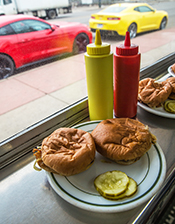From the June 2016 issue
There are two kinds of people in this world: ketchup people and mustard people. I am a mustard man. Nothing against ketchup, mind you. It’s just that it’s basically sugar made red and viscous. It’s the condiment of choice for people who order off the kid’s menu. Mustard, though, is beguiling and complex. From sweet to sinus-scorchingly spicy, mustards can thrill all the tongue’s taste buds.
Yes, we know there are those who use both the king and the queen of condiments, but we think those people just lack commitment.
Similarly, there are Ford Mustang people and Chevy Camaro people. And there are fans of turbos and adherents to naturally aspirated mills. Convenient, then, that we just happen to have a Heinz-red Mustang EcoBoost and a French’s-yellow Camaro LT V-6. And if you think this sounds like a very elaborate scheme to justify expensing a lunch of old-school sliders and fries at southwest Detroit’s venerable Telway Hamburgers stand, well, you’re not entirely correct.
That’s because in any war between turbocharged engines and naturally aspirated ones, the Mustang/Camaro battle is unique, important, and extremely worthy of contemplation. As of this year, each company serves up its sports coupe with a choice of three engines: a turbocharged four-cylinder, a V-6, and a V-8. Where the two companies differ is in the placement of these engines in their hierarchies. Ford, the first to turbocharge its current model, regards the EcoBoost as its middle-rung Mustang—the performance-oriented pony car for those who don’t want to pony up for the V-8. It’s powered by a 310-hp 2.3-liter four-cylinder and is offered with the full complement of performance- and luxury-enhancing options. The base Mustang is the one powered by the 300-hp 3.7-liter V-6. It is mostly foisted on rental-car companies, and Ford offers it with none of the options that a performance enthusiast might crave.
|
The Camaro’s ripping exhaust livened things up on a dreary Detroit day. The Mustang’s? Not so much. |
Chevrolet flips the order. A newly available 275-hp turbocharged 2.0-liter four-cylinder powers the base-level Camaro. The version priced and positioned to go against the EcoBoost Mustang is the one powered by the new 335-hp 3.6-liter V-6.
We specified six-speed manuals for our two performance-minded non–V-8s, because we prefer manuals and because it allowed us to test each car’s throttle response [see page 058]. Can a punchy, turbocharged four-cylinder usurp a higher-revving, larger-displacement V-6 in a class of cars where driving exhilaration trumps fuel economy?
We would find out on a mix of our 10Best testing roads, expressways, and Detroit’s cratered byways. We would also eat burgers and fries. With mustard.
Powered by WPeMatico






